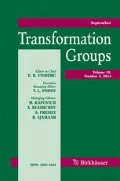Abstract
LetG be a complex connected reductive group. Well known wonderfulG-varieties are those of rank zero, namely the generalized flag varietiesG/P, those of rank one, classified in [A], and certain complete symmetric varieties described in [DP] such as the famous space of complete conics. Recently, there is a renewed interest in wonderful varieties of rank two since they were shown to hold a keystone position in the theory of spherical varieties, see [L], [BP], and [K].
The purpose of this paper is to give a classification of wonderful varieties of rank two. These are nonsingular completeG-varieties containing four orbits, a dense orbit and two orbits of codimension one whose closuresD 1 andD 2 intersect transversally in the fourth orbit which is of codimension two. We have gathered our results in tables, including isotropy groups, explicit basis of Picard groups, and several combinatorial data in relation with the theory of spherical varieties.
Similar content being viewed by others
References
D. Akhiezer,Equivariant completion of homogeneous algebraic varieties by homogeneous divisors, Ann. Glob. Analysis and Geometry1 (1983), 49–78.
A. Biaŀynicki-Birula,On induced actions of algebraic groups, Ann. Inst. Fourier Grenoble43, 2 (1993), 359–364.
M. Brion, D. Luna et Th. Vust,Espaces homogènes sphériques, Invent. Math.84 (1986), 617–632.
N. Bourbaki,Groupes et Algèbres de Lie, Chap. IV, V, VI, 2e édition, Masson, Paris, 1981.
M. Brion, et F. Pauer,Valuations des espaces homogènes sphériques, Comment. Math. Helv.62 (1987), 265–285.
M. Brion,Classification des espaces homogènes sphériques, Compositio Math.63 (1987), 189–208.
M. Brion,On spherical varieties of rank one, CMS Conf. Proc.10 (1989), 31–41.
M. Brion,Groupe de Picard et nombres caractéristiques des variétés sphériques, Duke Math.58, 2 (1989), 397–424.
M. Brion,Vers une généralisation des espaces symétriques, J. Algebra134 (1990), 115–143.
A. Borel, et J. Tits,Eléments unipotents et sous-groupes paraboliques de groupes réductifs I, Invent. Math.12 (1971), 95–104.
C. De Concini, and C. Procesi,Complete symmetric varieties, in Invariant theory, Proceedings, Montecatini (F. Gherardelli, ed.); Lect. Notes Math. 996, Springer-Verlag, 1983, 1–44.
W. Fulton,Introduction to Toric Varieties, Annals of Math. Studies 131, Princeton University Press, 1993.
F. Knop, H. Kraft, D. Luna, and Th. Vust,Local properties of algebraic group actions, in: Algebraische Transformationsgruppen und Invariantentheorie (H. Kraft, P. Slodowy, and T. Springer, ed.); DMV Semin. 13, Birkhäuser, Basel-Boston-Berlin, 1989, 63–76.
F. Knop,Automorphisms, root systems, and compactifications of Homogeneous Varieties, J. Amer. Math. Soc., Vol.9, 1 (1996), 153–174.
F. Knop,The Luna-Vust theory of spherical embeddings, in: Proc. of the Hyderabad Conf. on Algebraic Groups, Manoj Prakashan, Madras, 1991, 225–249.
M. Krämer,Sphärische Untergrupen in kompakten zusammen hängenden Lie Gruppen, Compositio Math.38 (1979), 129–153.
D. Luna,Toute variété magnifique est sphérique, Transformation Groups1, 3 (1996), 249–258.
D. Luna,Grosses cellules pour les variétés sphériques, in: Algebraic Groups and Related Subjects. Volume in honor of R. W. Richardson (G. I. Lehrer, et al., ed.); Cambridge University Press, 1996.
D. Luna, et Th. Vust,Plongements d’espaces homogènes, Comment. Math. Helv.58 (1983), 186–245.
I. Mikityuk,On the integrability of invariant hamiltonian systems with homogeneous configuration spaces, Math. USSR, Sb.57 (1987), 527–546.
G. Mostow,Fully reducible subgroups of algebraic groups, Amer. J. Math.78 (1956), 200–221.
A. L. Onishchik, and E. B. Vinberg,Seminar on Lie groups and Algebraic Groups, Berlin, Springer-Verlag, 1990.
F. Pauer,Caractérisation valuative d’une classe de sous-groupes d’un groupe algébrique, C.R. 109e Cong. Nat. Soc. Sav. Dijon Sci.3 (1984), 159–166.
H. Sumihiro,Equivariant completion, J. Math. Kyoto Univ.14 (1974), 1–28.
Author information
Authors and Affiliations
Rights and permissions
About this article
Cite this article
Wasserman, B. Wonderful varieties of rank two. Transformation Groups 1, 375–403 (1996). https://doi.org/10.1007/BF02549213
Received:
Accepted:
Issue Date:
DOI: https://doi.org/10.1007/BF02549213



